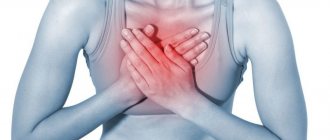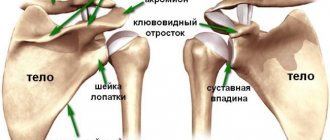Pain when taking a deep breath
General information
Pain with deep inspiration, coughing, or other respiratory movements usually points to the pleura and pericardial region or mediastinum as a possible source of pain, although pain in the chest wall is also likely influenced by respiratory movements and has nothing to do with heart disease. Most often, the pain is localized in the left or right side and can be either dull or sharp.
reasons for occurrence
The main causes of pain when taking a deep breath:
1. Pain when taking a deep breath occurs due to inflammation of the membrane lining the inside of the chest cavity and covering the lungs. Dry pleurisy can occur with various diseases, but most often with pneumonia. Pain during dry pleurisy decreases when lying on the affected side. There is a noticeable limitation in the respiratory mobility of the corresponding half of the chest; with unchanged percussion sound, weakened breathing may be heard due to the patient sparing the affected side, and pleural friction noise. Body temperature is often subfebrile, there may be chills, night sweats, and weakness.
2. Restriction of chest movement or pain during deep inspiration and exhalation with shallow breathing is observed with functional disorders of the costal frame or thoracic spine (limited mobility), pleural tumors, pericarditis.
3. With dry pericarditis, the pain intensifies with deep inspiration and movements, so the depth of breathing decreases, which aggravates shortness of breath. The intensity of pain when inhaling varies from slight to severe.
4. When the interpleural ligament is shortened, a constant cough is observed, which intensifies when talking, taking a deep breath, physical activity, stabbing pain when taking a deep breath, or running. The interpleural ligament is formed from the fusion of the visceral and parietal layers of the pleura of the root of the lung. Further, descending caudally along the medial edge of the lungs, this ligament branches in the tendon part of the diaphragm and its legs. The function is to provide springy resistance during caudal displacement of the diaphragm. In the presence of an inflammatory process, the ligaments shorten and limit caudal displacement
5. With intercostal neuralgia, sharp “shooting” pains occur along the intercostal spaces, sharply intensifying with deep inspiration.
6. With renal colic, the pain is localized in the right hypochondrium and in the epigastric region and then spreads throughout the abdomen. The pain radiates under the right shoulder blade, to the right shoulder, intensifies with a deep breath, as well as with palpation of the gallbladder area. Local pain is observed when pressing in the area of the X-XII thoracic vertebrae 2-3 transverse fingers to the right of the spinous islands.
7. A blow or compression of the chest can cause rib fractures. With such damage, a person feels sharp pain when taking a deep breath and coughing.
8. Pain when taking a deep breath may also indicate the presence of osteochondrosis of the thoracic spine.
How does the violation manifest itself?
When there is a lack of air, a person is unable to breathe normally. Shortness of breath occurs, breathing movements become rapid. Against this background, general health deteriorates significantly. If there is constantly not enough air when breathing, the patient fears for his own life.
The feeling of lack of air can occur at rest and during physical activity, and have varying degrees of intensity. In any case, such a condition should not be ignored. Even if rare episodes occur, you should always consult a doctor.
Diagnosis of rib pain
If you are suffering from rib pain, contact the CELT Pain Clinic. We employ doctors of various specialties who will use the entire arsenal of diagnostic and treatment capabilities of our multidisciplinary clinic to solve your problems. Since there are many reasons that cause pain in the ribs, it is very important to correctly diagnose. This is the only way to correctly diagnose and prescribe treatment.
If you experience pain, contact one of our specialists:
- therapist;
- neurologist;
- traumatologist;
- pulmonologist;
- cardiologist.
Diagnosis in our Pain Clinic, in addition to examination by a doctor and medical history, may include:
- laboratory research methods;
- cardiography;
- computed tomography;
- magnetic resonance imaging.
Stomach ulcer
With a perforated stomach ulcer, pain may also occur under the left rib in front. This symptom is preceded by signs characteristic of colitis (flatulence, bloating). Then the person is overtaken by pain, it is dagger-like and strong. Sometimes tolerable, and sometimes capable of causing loss of consciousness, it can shift slightly to the right.
Often pain occurs after eating. Accompanied by other symptoms: nausea, loss of appetite, vomiting, belching with an unpleasant aftertaste. If cutting, stabbing pain occurs and there is a history of a stomach ulcer, urgent hospitalization is necessary.
Survey
Patients with complaints of difficulty in exhaling most often turn to a pulmonologist or therapist. Expiratory shortness of breath indicates serious disorders in the respiratory system, so a comprehensive laboratory and instrumental examination is necessary. During the diagnosis, the specialist evaluates the morphological features of the trachea, bronchi and lungs, and also examines the functional state of these organs. The most informative are:
- X-ray examination
. To study the features of the anatomical structures of the chest cavity, a standard chest x-ray is performed in two projections - frontal and lateral. The method helps to detect deformations of the bronchi and trachea, signs of sclerosis and emphysema. For better visualization of the respiratory tract and neighboring organs, it is prescribed. - Bronchoscopy
. Endoscopic examination is aimed at studying the structure of the mucous membrane, identifying pathologically altered areas of tissue and cicatricial stenoses. According to indications, the method is supplemented with forceps biopsy and bronchoalveolar lavage, followed by microscopic and bacteriological analysis of rinsing water. - Spirometry
. The nature of breathing difficulty can be established by studying the main indicators - forced expiratory volume in the first second, functional vital capacity of the lungs, Tiffno index. For differential diagnosis between bronchial asthma and other obstructive pulmonary diseases, a bronchodilator test is recommended. - Lab tests
. The degree of respiratory failure is determined according to blood tests - the level of hemoglobin oxygen saturation and the concentration of carbon dioxide are determined. In the presence of a general infectious syndrome, a bacteriological blood test is indicated. To clarify the type of pathogen, serological reactions are carried out (RIF, ELISA, PCR).
To determine the etiological factor of bronchial obstruction in the remission phase, allergy tests are prescribed. If a congenital disease of the respiratory system is suspected, consultation with other specialists is required.
Spirometry
Lung cancer
With cancer of the left lung, when the tumor grows into the pleura, pain appears in the chest. They usually appear at a late stage. The pain radiates to the neck, arm and stomach. It can be sharp and stabbing. Often has a girdling character.
This symptom is accompanied by others characteristic of lung cancer:
- This is primarily a cough.
- The patient suffers from lack of appetite and rapidly loses weight.
The signs of this pathology are in many ways similar to dry pleurisy. And pain in the left side when inhaling is one of the common symptoms. Pleurisy is often the first and only manifestation of tuberculosis, occurring at its initial stage. It is diagnosed when there are foci of disease in the lungs or lymph nodes.
Tuberculous pleurisy can be purulent. Accompanied by fever, increased sweating, shortness of breath, chills. A person suddenly loses weight.
Treatment
Since chest pain during inspiration can be caused by pathologies of different organs and systems, their treatment tactics will vary significantly.
Myocardial infarction and pulmonary embolism can be treated with thrombolysis - intravenous administration of drugs that can “dissolve” blood clots. However, such procedures are effective in the first 4-6 hours from the moment pain appears. At a later date, other treatment methods are used.
Other cardiac causes may require normalization of blood pressure, heart rate with the help of appropriate medications, restoration of heart valve function by replacing them, etc.
Infectious lesions of the lungs, accompanied by pain in the heart area, may require the use of antibacterial or antiviral agents. For bronchial asthma, the treatment regimen includes β2-agonists, glucocorticosteroids, etc.
Gastrointestinal pathologies can be brought under control by normalizing nutrition and physical activity; doctors advise fighting obesity and taking medications that affect the pH level of the stomach cavity.
Intercostal neuralgia is treated with analgesics, non-steroidal anti-inflammatory drugs, B vitamins and muscle relaxants.
In case of psychogenic cardialgia, it is recommended to consult a medical psychologist or psychiatrist to decide on the need to use sedatives.
Heart diseases
Pain in the left hypochondrium may well be caused by heart diseases, such as ischemia, angina, cardiomyopathy and others. The most serious of them is myocardial infarction. Pain in this case is accompanied by both the development of the pathology and the condition preceding it.
Associated signs indicating a heart attack:
- dyspnea;
- chills;
- cold clammy sweat;
- nausea;
- vomit;
- diarrhea;
- sharp pallor of the face (even to the point of cyanosis) and puffiness;
- numbness of hands.
Pain on the left side can radiate to the shoulder blade, shoulder, or neck. It is sharp, burning (and not aching, as, for example, with colitis), accompanied by heaviness behind the sternum. If you have such symptoms, you should immediately call an ambulance, as this is a life-threatening condition.
MBST therapy
MBST therapy is a therapeutically advanced nuclear magnetic resonance technology used in the treatment of diseases and injuries of the musculoskeletal system. Nuclear magnetic resonance technology is used to treat chest pain. The purpose of using MBST therapy is to initiate recovery processes. After the procedure, pain and inflammation in the affected area disappear.
You can sign up for the MBST therapy procedure in Moscow for the treatment of a thoracic hernia at ArthroMedCenter.
Pain in the left side of the chest can develop for various reasons. Diseases of various organs (lungs, heart, spine) can provoke the appearance of such a sign. If you notice chest pain on the left, you should definitely consult a doctor and undergo an examination.
Difficulty breathing - causes of the disorder
The feeling that there is not enough air in the lungs is not always due to any disease. This phenomenon can occur during physical exertion, emotional shock, or sudden climate change. If the feeling of shortness of breath bothers you regularly, this may be due to serious problems:
- diseases of the heart muscle;
- vegetative-vascular dystonia;
- pulmonary pathologies;
- the presence of foreign bodies in the respiratory tract;
- diabetes mellitus;
- oncology;
- infectious processes.
Other causes of difficulty breathing are active smoking, a tendency to allergies, excess body weight, and nervous disorders. The problem often occurs during pregnancy and is associated with bearing a large fetus, twins or triplets, and polyhydramnios.










